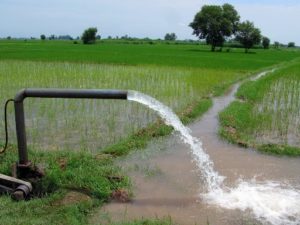Energy Efficiency Services Ltd is associated with the Agriculture Demand Side Management (AgDSM) programme that aims at replacing a whopping 20 million inefficient pumps currently deployed in the agricultural sector. Rajneesh Rana, General Manager, Contracts Department, Energy Efficiency Services Ltd, speaks to T&D India on the scope of this massive programme, the challenges in store, and how the nation, thanks to the endeavour, stands to gain enormously through energy savings and lower carbon emissions.

We understand that the AgDSM programme involves replacement of existing (inefficient) pump sets with energy-efficient ones. Tell us about the scope in detail. We specifically would like to know how many pump sets in totality will be replaced, pan India.
Agriculture is the backbone of the Indian economy and the sector accounts for about 18.5 per cent of the total energy consumption in India. An estimated 20 million agricultural pump sets are connected to the grid in India, to meet the irrigation needs of Indian farmers. Due to affordability, locally made inefficient pump sets that contribute to both energy and water wastage are being used by Indian farmers. Therefore, managing agricultural load is increasingly becoming a challenge for electric utilities in India. Further, with access to heavily subsidized water and electricity, farmers need a viable incentive to adopt more energy efficient practices. Therefore, upgrade of existing pumping system presents an immediate need and an unprecedented opportunity to meet this requirement.
Adding to this, implementation of this programme is also crucial as energy bills for agricultural pump sets are being paid by the government in form of subsidies. Energy saving therefore, directly benefits the government and DISCOMS. At EESL, initially, we implemented some small agricultural pump set projects targeting various states in India. Moving a step ahead, we are currently implementing the largest pump set programme in Andhra Pradesh.
What is the timeframe of completion?
The existing programme which is the largest so far should be completed by this year. We have also been approached by other states for the implementation of the AgDSM project and are hoping to complete the programme in the next five years.
We learn that an order of Rs.150 crore has been placed on CRI Pumps to supply BEE-certified 5-star pump sets to Telangana. Is this the first order under AgDSM?
CRI Pumps is amongst three more prominent pump manufacturers who was awarded the order for supply of BEE-5 star rated pump set and smart control panel for Andhra Pradesh.
Replacing an estimated 20 million pump sets used in agriculture sector with energy efficient pump sets would result in annual energy savings of around 56 billion kWh equivalent to around Rs.24,000 crore.
Has EESL already empaneled suppliers to supply these energy-efficient pumps? How is the selection of supplier done?
The selection of the suppliers is mainly done through an open – competitive bidding process.
What is the means of financing?
 EESL primarily works on two modes – ESCO and PMC. Under the ESCO mode, EESL facilitates the entire upfront investments and recovers the cost over a mutually agreed period by monetizing energy savings, while in PMC mode, investment is done by the state government (or discom), while EESL implements the overall project as a project management consultant.
EESL primarily works on two modes – ESCO and PMC. Under the ESCO mode, EESL facilitates the entire upfront investments and recovers the cost over a mutually agreed period by monetizing energy savings, while in PMC mode, investment is done by the state government (or discom), while EESL implements the overall project as a project management consultant.
How many pump sets are operational in India and what would be the energy saving realized if all were to be replaced by energy-efficient ones?
Replacing an estimated 20 million pump sets used in agriculture sector with energy efficient pump sets would result in annual energy savings of around 56 billion kWh equivalent to around Rs.24,000 crore, and GHG emission reduction of 45 million tonnes of CO2 annually.
What would the role of state governments in facilitating AgDSM in their respective states?
AgDSM Project is implemented in coordination with the state govt. and discom. The state governments are a crucial entity to promote AgDSM schemes as they play a critical role in spreading a positive message among various stakeholders including farmers who need to be aware of the benefits and be motivated enough to join such schemes.
Pump ownership with 2-3 members of family is one of the hurdles for entering into pump replacement agreement.
What challenges do you foresee in the ground-level implementation of AgDSM?
 While the implementation of AgDSM program promises a lot of benefits for all its stakeholders, there are some challenges that exist at present which need to be overcome to realise the actual benefits. Some of the key challenges are: ignorance regarding DSM; failure of past programs discourage the end users to participate in new schemes; fear of loss of control, productivity and comfort; limited or no knowledge of energy efficient pump sets and technology; perceived risk in adopting new technology; limited financial resources; high first cost and limited returns due to subsidized electricity tariff; unavailability of local technology/ service provider for energy efficient products; no financial commitment by end users under ESCO mode means limited ownership.
While the implementation of AgDSM program promises a lot of benefits for all its stakeholders, there are some challenges that exist at present which need to be overcome to realise the actual benefits. Some of the key challenges are: ignorance regarding DSM; failure of past programs discourage the end users to participate in new schemes; fear of loss of control, productivity and comfort; limited or no knowledge of energy efficient pump sets and technology; perceived risk in adopting new technology; limited financial resources; high first cost and limited returns due to subsidized electricity tariff; unavailability of local technology/ service provider for energy efficient products; no financial commitment by end users under ESCO mode means limited ownership.
Do you anticipate problems with relation to pump set ownership?
Yes, pump ownership with 2-3 members of family is one of the hurdles for entering into pump replacement agreement. Farmers are sometimes reluctant to give back old inefficient pump sets.
Other than that, there are low voltage issues and availability of power supply from discoms. Sometimes, improper pumping system calls for changing the entire system along with discharge and all the accessories to achieve better performance of pump set.


